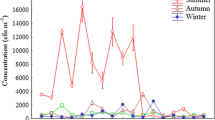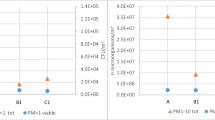Abstract
The biological loading of viable, cultivable airborne microbes (heterotrophic bacteria, actinobacteria and fungi) in 6 size fractions as well as the three different fractions of respirable particulate matter (PM1, PM2.5 and PM10) and their relationship to meteorological conditions were studied in the ambient air due to health-related interests. An Andersen six stage viable particle impactor and a MAS 100 sampler were used for microbial measurements. 82 measurements were performed at three different periods (41 days) at a suburban, residential site in the city of Chania (Crete, Greece) during the period from April 2008 to June 2009. The concentrations of the viable, cultivable airborne microbes (bioaerosols) as well as of the PM1, PM2.5 and PM10 were highly variable during the whole measurement period. Among the airborne microbes, fungi presented the most abundant taxonomic group in the ambient air. A characteristic profile of the mean size distribution of biological loading in different PM fractions was obtained for every measured microbial taxonomic group. Although, the highest concentrations of the airborne fungi and actinobacteria were determined at aerodynamic diameters between 2.1 and 3.3 μm, a nearly equal distribution of the mean concentrations of the airborne heterotrophic bacteria was observed in the six different size fractions. However, two small maxima were observed at the airborne heterotrophic bacteria distribution, one at the fraction with aerodynamic diameters between 1.1 and 2.1 μm, and at other at the coarse fraction with aerodynamic diameter larger than 7 μm. A considerable part of the airborne microbes Cycloheximide per mL of growth medium of bacteriwere resistant to drugs. Between 10 and 40 % of the viable, cultivable airborne microbes were resistant to low concentrations of drugs (5–10 μg of Streptomycin or a or fungi, respectively). Furthermore, multiple linear regression of the data showed that the variation in fungi concentrations depends on the variation in PM10 mass concentration, PM1 number concentration, relative humidity and solar radiation. Likewise, the concentration of heterotrophic bacteria was found proportional to the values of relative humidity and fungal concentration, whereas was negatively correlated to the solar radiation.






Similar content being viewed by others
References
Adhikari, A., Reponen, T., Grinshpun, S. A., Martuzevicius, D., & LeMasters, G. (2006). Correlation of ambient inhalable bioaerosols with particulate matter and ozone: A two-year study. Environmental Pollution, 140, 16–28.
Amann, R. I., Ludwig, W., & Schleifer, K. H. (1995). Phylogenetic identification and in situ detection of individual microbial cells without cultivation. Microbiological Reviews, 59(1), 143–169.
Amato, P., Parazols, M., Sancelme, M., Laj, P., Mailhot, G., & Delort, A.-M. (2007). Microorganisms isolated from the water phase of tropospheric clouds at the Puy de Dôme: Major groups and growth abilities at low temperatures. FEMS Microbiology Ecology, 59, 242–254.
Ariya, P. A., & Amyot, M. (2004). New directions: The role of bioaerosols in atmospheric chemistry and physics. Atmospheric Environment, 38, 1231–1232.
Bauer, H., Kasper-Giebl, A., Zibuschka, F., Hitzenberger, R., Kraus, F. G., & Puxbaum, H. (2002). Determination of the carbon content of airborne fungal spores. Analytical Chemistry, 74(1), 91–95.
Boreson, J., Dillner, A. M., & Peccia, J. (2004). Correlating bioaerosol load with PM2.5 and PM10cf concentrations: A comparison between natural desert and urban-fringe aerosols. Atmospheric Environment, 38, 6029–6041.
Brodie, E. L., DeSantis, T. Z., Moberg Parker, J. P., Zubietta, I. X., Piceno, Y. M., & Andersen, G. L. (2007). Urban aerosols harbor diverse and dynamic bacterial populations. Proceedings of the National academy of Sciences of the United States of America, 104, 299–304.
Burch, M., & Levetin, E. (2002). Effects of meteorological condition on spore plumes. International Journal of Biometeorology, 46, 107–117.
Cheng, S. M., & Foght, J. M. (2007). Cultivation-independent and -dependent characterization of bacteria resident beneath John Evans Glacier. FEMS Microbiology Ecology, 59, 318–330.
Després, V. R., Huffman, J. A., Burrows, S. M., Hoose, C., Safatov, A. S., Buryak, G., et al. (2012). Primary biological aerosol particles in the atmosphere: A review. Tellus B, 64, 15598. doi:10.3402/tellusb.v64i0.15598.
Draxler, R. R., & Rolph, G. D. (2003). HYSPLIT (HYbrid single-particle lagrangian integrated trajectory). Model access via NOAA ARL READY. Website NOAA Air Resources Laboratory, Silver Spring, MD. Retrieved from http://www.arl.noaa.gov/ready/hysplit4.html. Accessed 20 Nov 2011.
EMEP. (2011). Transboundary particulate matter in Europe. EMEP Report 4.
Fierer, N., Liu, Z., Rodríguez-Hernández, M., Knight, R., Henn, M., & Hernandez, M. T. (2008). Short-term temporal variability in airborne bacterial and fungal populations. Applied and Environmental Microbiology, 74(1), 200–207.
Garrison, V. H., Foreman, W. T., Genualdi, S., Griffin, D. W., Kellogg, C. A., Majewski, M. S., et al. (2006). Saharan dust—a carrier of persistent organic pollutants, metals and microbes to the Caribbean? Revista de Biologia Tropical (International Journal of Tropical Biology and Conservation), 54(3), 9–21.
Gomiscek, B., Hauck, Η., Stopper, S., & Preining, O. (2004). Spatial and temporal variations of PM1, PM2.5, PM10 and particle number concentration during the AUPHEP—project. Atmospheric Environment, 38, 3917–3934.
Griffin, D. W., Garrison, V. H., Herman, J. R., & Shinn, E. A. (2001). African desert dust in the caribbean atmosphere: Microbiology and public health. Aerobiologia, 17, 203–213.
Griffin, D. W., Kellogg, C. A., Garrison, V. H., Lisle, J. T., Borden, T. C., & Shinn, E. A. (2003). Atmospheric microbiology in the northern Caribbean during African dust events. Aerobiologia, 19, 143–157.
Hinds, W. C. (1999). Aerosol technology. London: Wiley.
Jaenicke, R. (2005). Abundance of cellular material and proteins in the atmosphere. Science, 308, 73.
Jones, A. M., & Harrison, R. M. (2004). The effects of meteorological factors on atmospheric bioaerosol concentrations—a review. Science of the Total Environment, 326, 151–180.
Kalogerakis, N., Paschali, D., Lekaditis, V., Pantidou, A., Eleftehriadis, K., & Lazaridis, M. (2005). Indoor air quality -bioaerosol measurements in domestic and office premises. Journal of Aerosol Science, 36, 751–761.
Karra, S., & Katsivela, E. (2007). Microorganisms in bioaerosol emissions from wastewater treatment plants during summer at a Mediterranean site. Water Research, 41, 1355–1365.
Kellogg, C. A., Griffin, D. W., Garrison, V. H., Peak, K. K., Royall, N., Smith, R. R., et al. (2004). Characterization of aerosolized bacteria and fungi from desert dust events in Mali, West Africa. Aerobiologia, 20, 99–110.
Kopanakis, I., Eleftheriadis, K., Mihalopoulos, N., Lydakis-Simantiris, N., Katsivela, E., Pentari, D., et al. (2012). Physico-chemical characteristics of particulate matter in the Eastern Mediterranean. Atmospheric Research, 106, 93–107.
Lazaridis, M., Dzumbova, L., Kopanakis, I., Ondracek, J., Glytsos, T., Aleksandropoulou, V., et al. (2008). PM10 and PM2.5 levels in the Eastern Mediterranean (Akrotiri Research Station, Crete, Greece). Water, Air, and Soil pollution, 189, 85–101.
Li, M., Qi, J., Zhang, H., Huang, S., Li, L., & Gao, D. (2011). Concentration and size distribution in an outdoor environment in the Qingdao coastal region. Science of the Total Environment, 409, 3812–3819.
Lighthart, B. (1997). The ecology of bacteria in the alfresco atmosphere. FEMS Microbiology Ecology, 23, 263–274.
Macher J., Ammann H. A., Burge H. A., Milton D. K., & Morey P. R. (1998). Bioaerosols: Assessment and control, American Conference of Governmental Industrial Hygienists, Cincinnati, OH, Cincinnati, USA.
Maier, R. M., Pepper, I. L., & Gerba, C. P. (2000). Environmental microbiology. San Diego, California: Academic Press.
Maron, P.-A., Lejon, D. P. H., Calvalho, E., Bizet, K., Lemanceau, P., Ranjard, L., et al. (2005). Assessing genetic structure and diversity of airborne bacterial communities by DNA fingerprinting and 16S rDNA clone library. Atmospheric Environment, 39, 3687–3695.
Martinez, J. L. (2012). Bottlenecks in the transferability of antibiotic resistance from natural ecosystems to human bacterial pathogens. Frontiers in Microbiology, 2, 265. doi:10.3389/fmicb.2011.00265.
Matthais-Maser, S., Obolkin, V., Khodzer, T., & Jaenicke, R. (2000). Seasonal variation of primary biological aerosol particles in the remote continental region of Lake Baikal/Siberia. Atmospheric Environment, 34, 3805–3811.
Meretrez, M. Y., Foarde, K. K., Esch, R. K., Schwartz, T. D., Dean, T. R., Hays, M. D., et al. (2009). An evaluation of indoor and outdoor biological particulate matter. Atmospheric Environment, 43, 5476–5483.
Morris, C. E., Sands, D. C., Bardin, M., Jaenicke, R., Vogel, B., Leyronas, C., et al. (2011). Microbiology and atmospheric processes: Research challenges concerning the impact of airborne micro-organisms on the atmosphere and climate. Biogeosciences, 8, 17–25.
Oliveira, M., Ribeirio, H., Delgado, J. L., & Abreu, I. (2009). The effects of meteorological factors on airborne fungal spore concentration in two areas differing in urbanisation level. International Journal of Biometeorology, 53, 61–73.
Parat, S., Perdrix, A., Mann, S., & Baconnier, P. (1999). Contribution of particle counting in assessment of exposure to airborne microorganisms. Atmospheric Environment, 33, 951–959.
Pascual, L., Perez-Luz, S., Adela Yanez, M., Santamaria, A., Gibert, K., Salgot, M., et al. (2003). Bioaerosol emission from wastewater treatment plants. Aerobiologia, 19, 261–270.
Patrikis, N., Lazaridis, M., & Katsivela, E. (2009). Antibiotic-resistant airborne microbial concentrations and particulate matter indoor/outdoor levels. In e-Proceedings of the 11th International Conference on Environmental Science and Technology (CEST2009) (pp. 725–729). Chania, Crete, Greece, September 3rd–5th, 2009.
Perez, N., Pey, J., Cusack, M., Reche, C., Querol, X., Alastuey, A., et al. (2010). Variability of particle number, black carbon, and PM10, PM2.5, and PM1 levels and speciation: Influence of road traffic emissions on urban air quality. Aerosol Science and Technology, 44, 487–499.
Pey, J., Rodriguez, S., Querol, X., Alastuey, A., Moreno, T., Puatud, J. P., et al. (2008). Variations of urban aerosols in the western Mediterranean. Atmospheric Environment, 42, 9052–9062.
Polymenakou, P. N., Mandalakis, M., Stephanou, E. G., & Tselepides, A. (2008). Particle size distribution of airborne microorganisms and pathogens during an intense african dust event in the eastern Mediterranean. Environmental Health Perspectives, 116, 292–296.
Pyrri, I., & Kapsanaki-Gotsi, E. (2011). Diversity and annual fluctuations of cultivable airborne fungi in Athens, Greece: A 4-year study. Aerobiologia. doi:10.1007/s10451-011-9233-z.
Raisi, L., Lazaridis, M., & Katsivela, E. (2010). Relationship between airborne microbial and particulate matter concentrations in the ambient air at a Mediterranean site. Global Nest Journal, 12(1), 84–91.
Ranalli, G., Principi, P., & Sorlini, C. (2000). Bacterial aerosol emission from wastewater treatment plants: Culture methods and biomolecular tools. Aerobiologia, 16, 39–46.
Rappé, M. S., & Giovannoni, S. J. (2003). The uncultured microbial majority. Annual Reviews of Microbiology, 57, 369–394.
Rolph, G.D. (2003). Real-time environmental applications and display system (READY). Website NOAA air resources laboratory, Silver Spring, MD. Retrieved from http://www.arl.noaa.gov/ready/hysplit4.html. Accessed 20 Nov 2011.
Schlesinger, P., Mamame, Y., & Grishkan, I. (2006). Transport of microorganisms to Israel during Saharan dust events. Aerobiologia, 22, 259–273.
Schütz L., Jaenicke R., & Pietreck H. (1981). Sahara dust transport over the North Atlantic Ocean. In T. L. Pèwè (Ed.), Desert dust, Vol. 187 Geological Society of America, pp. 87–100.
Shaffer, B. T., & Lighthart, B. (1997). Survey of the cultivable airborne bacteria at four diverse locations in Oregon: Urban, rural, forest and coastal. Microbial Ecology, 34, 167–177.
Stelzenbach, L. D. (2007). Introduction to aerobiology. In C. J. Hurst, et al. (Eds.), Manual of environmental microbiology (pp. 925–938). Washington, DC: ASM Press.
Tong, Y., & Lighthart, B. (2000). The annual bacterial particle concentration and size distribution in the ambient atmosphere in a rural area of the Willamette Valley, Oregon. Aerosol Science and Technology, 32, 393–403.
Urbano, R., Palenik, B., Gaston, C. J., & Prather, K. A. (2011). Detection and phylogenetic analysis of coastal bioaerosols using culture depended and independent techniques. Biogeosciences, 8, 301–309.
USEPA. (2004). Air quality criteria for particulate matter. Research Triangle Park, NC. EPA/600/P-99/002aD.
Winiwarter, W., Bauer, H., Caseiro, A., & Puxbaum, H. (2009). Quantifying emissions of primary biological aerosol particle mass in Europe. Atmospheric Environment, 43, 1403–1409.
Acknowledgments
The authors gratefully acknowledge the NOAA Air Resources Laboratory (ARL) for the provision of the HYSPLIT transport and dispersion model (http://www.arl.noaa.gov/ready.html) used in this publication.
Author information
Authors and Affiliations
Corresponding author
Rights and permissions
About this article
Cite this article
Raisi, L., Aleksandropoulou, V., Lazaridis, M. et al. Size distribution of viable, cultivable, airborne microbes and their relationship to particulate matter concentrations and meteorological conditions in a Mediterranean site. Aerobiologia 29, 233–248 (2013). https://doi.org/10.1007/s10453-012-9276-9
Received:
Accepted:
Published:
Issue Date:
DOI: https://doi.org/10.1007/s10453-012-9276-9




